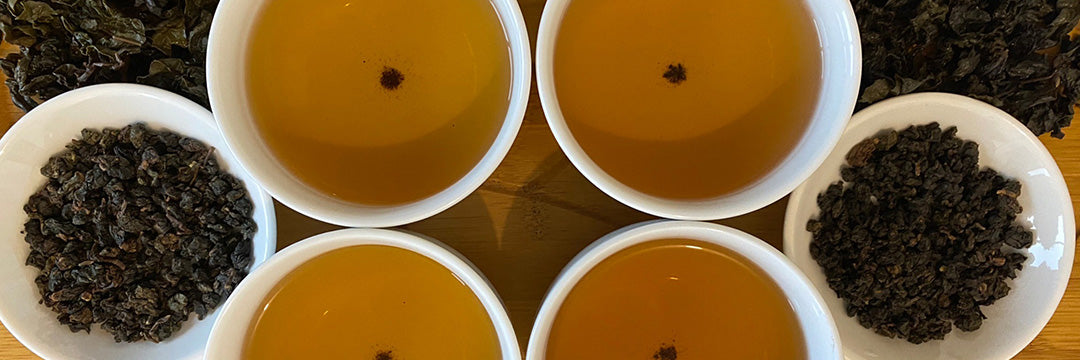
Oolong Tea Roasted Over 3 Weeks vs. 3 Years

Shown above are two of our heavy roast Oolong Tea selections that we brewed side by side to compare and contrast their flavor profiles that result from their post production processing. Namely, roasting methods and resting intervals. On the left we have our Roasted Tsui Yu Oolong, and on the right we have our Eco-Farmed Heavy Roast Oolong. Tsui Yu (Tai Cha #13) is a hybrid tea cultivar produced by Taiwan's Tea Research and Extension Station at about the same time as Jin Xuan (Tai Cha #12). It had its heyday in the 1990's, and was renowned for it's distinctive aroma and substantial flavor profile. It became less and less popular in recent decades primarily due to fact that it is less prolific and less hardy than Jin Xuan and the more recently popular Four Seasons Spring cultivar.

Our Roasted Tsui Yu Oolong Tea is made from leaves that have undergone medium oxidation, and have been roasted 3-4 times for 10-15 hours per roasting, over a 3 week period. The temperature is gradually increased within each roasting, and incrementally increased with each successive roasting — reaching 130°C or more. This extensive roasting produces a full-bodied, bold, roasted flavor profile. It basically embodies the meaning of "roasted" without going too far. It has notes of toasted grains, roasted chicory, chocolate, coffee beans, campfire, leather, tobacco — it's dense, complex, and quite satisfying for us roasty toasty Oolong fans! The roasting is done by the most competent master roaster we know. He has an award winning track record that puts him in the upper echelon of the tea competition players in the industry. He also provides us with our Lugu Competition Grade Dong Ding Oolong Tea.

Eco-Farmed Heavy Roast Oolong is made from a combination of the above mentioned cultivars in roughly equal parts: Tsui Yu, Jin Xuan, and Four Seasons Spring. All of the tea leaves used to make this tea are produced from certified organic tea farms. They are are all made in the fashion of a traditional Oolong Tea, meaning that they are medium-well oxidized — perhaps 35-40%. Following the initial processing, the leaves are allowed to "rest" for 9-12 months before beginning their long and drawn out roasting process. They are roasted at relatively low temperature for at least 20 hours, then left to rest for 3 months. They are then roasted again in a similar fashion, left to rest for 3 months, and roasted once again in the same way. Then, they are allowed to settle for about 9 months, and undergo a final light roasting to remove any moisture that may have been absorbed. It's the longest and most time consuming tea processing recipe we have ever heard of!

This extensive roasting at lower than standard temperature, combined with long intervals of "rest" allows the leaves to mellow and the roasting effect to integrate into the original composition. The effect of allowing the leaves to rest for many months at a time results in a unique character of tea. It's really unlike any other Oolong we know of being made in Taiwan. The roasted character is subtle and blends with a broad spectrum of flavor notes. It is an Oolong character that is more akin to Wuyi Yan Cha from China than a Taiwanese made Oolong. It also has qualities that are reminiscent of Fo Shou Oolong. It's tangy/sweet on the palate, with mineral and woody notes, and finishes with mild smoke and preserved plum notes. It's soothing and satisfying in a distinctive way that makes you want to keep sipping to figure out what exactly it is that you are experiencing! Read more about this source and their decades of pioneering work on the product page.
Watch the tasting video for the full story and live commentary on both of these teas!
LET US KNOW!
Please post any questions or comments you may have in the comments section below!
SUBSCRIBE!
If you enjoyed this post and would like to hear more about the specialty tea industry here in Taiwan, follow us on YouTube, Facebook, and Instagram and please subscribe to our newsletter. Subscribe now and get US$5 off your first order!

